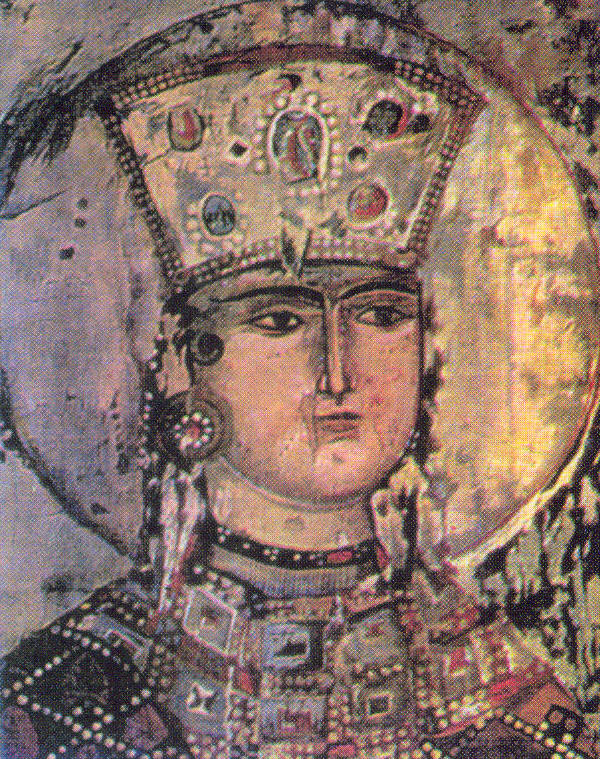
Tamar of Georgia
Tamar the Great (Georgian: თამარ მეფე, romanized: tamar mepe, lit. 'King Tamar'; c. 1160 – 18 January 1213) reigned as the Queen of Georgia from 1184 to 1213, presiding over the apex of the Georgian Golden Age.[2] A member of the Bagrationi dynasty, her position as the first woman to rule Georgia in her own right was emphasized by the title mepe ("king"), afforded to Tamar in the medieval Georgian sources.[3]
Tamar the Great
27 March 1184 – 18 January 1213[1]
1178 as co-regent
1184 as queen-regnant
Gelati Monastery
c. 1160
18 January 1213
(aged 52–53)
Agarani Castle
Yuri Bogolyubsky (1185–1187)
David Soslan (1191–1207)
Georgian Orthodox 

Royal monograms
Tamar was proclaimed heir and co-ruler by her reigning father George III in 1178, but she faced significant opposition from the aristocracy upon her ascension to full ruling powers after George's death. Tamar was successful in neutralizing this opposition and embarked on an energetic foreign policy aided by the decline of the hostile Seljuk Turks. Relying on a powerful military elite, Tamar was able to build on the successes of her predecessors to consolidate an empire which dominated the Caucasus until its collapse under the Mongol attacks within two decades after Tamar's death.[4]
Tamar was married twice, her first union being, from 1185 to 1187, to the prince Yuri of the Grand Principality of Vladimir, whom she divorced and expelled from the country, defeating his subsequent coup attempts. For her second husband Tamar chose, in 1191, the Alan prince David Soslan, by whom she had two children, George and Rusudan, the two successive monarchs on the throne of Georgia.[5][6]
Tamar's reign is associated with a period of marked political and military successes and cultural achievements. This, combined with her role as a female ruler, has contributed to her status as an idealized and romanticized figure in Georgian arts and historical memory. She remains an important symbol in Georgian popular culture.
Early life and ascent to the throne[edit]
Tamar was born in circa 1160 to George III, King of Georgia, and his consort Burdukhan, a daughter of the king of Alania. While it is possible that Tamar had a younger sister, Rusudan, she is only mentioned once in all contemporary accounts of Tamar's reign.[7] The name Tamar is of Hebrew origin and, like other biblical names, was favored by the Georgian Bagrationi dynasty because of their claim to be descended from David, the second king of Israel.[8]
Tamar's youth coincided with a major upheaval in Georgia; in 1177, her father, George III, was confronted by a rebellious faction of nobles. The rebels intended to dethrone George in favor of the king's fraternal nephew, Demna, who was considered by many to be a legitimate royal heir of his murdered father, David V. Demna's cause was little but a pretext for the nobles, led by the pretender's father-in-law, the amirspasalar ("high constable") Ivane II Orbeli, to weaken the crown.[9] George III was able to crush the revolt and embarked on a crackdown campaign on the defiant aristocratic clans; Ivane Orbeli was put to death and the surviving members of his family were driven out of Georgia. Demna, castrated and blinded on his uncle's order, did not survive the mutilation and soon died in prison.[10] Once the rebellion was suppressed and the pretender eliminated, George went ahead to co-opt Tamar into government with him and crowned her as co-ruler in 1178. By doing so, the king attempted to preempt any dispute after his death and legitimize his line on the throne of Georgia.[11] At the same time, he raised men from the Kipchaks as well as from the gentry and unranked classes to keep the dynastic aristocracy away from the center of power.[12]
